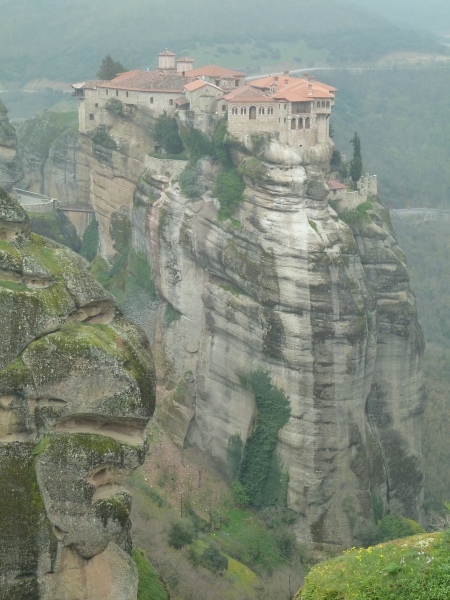Meteora was one of the most awe inspiring parts of our trip and we almost didn’t see any of it. We arrived late at night to the town of Kalambaka and we were excited wake up and see the towering rocks with ancient monasteries perched precariously on top. In the evening we determined that our balcony faced the famous rocks and I jumped out of bed in the morning and threw open the balcony doors to see … nothing. It was a sea of thick white fog. For all we knew the rocks didn’t even exist. Nevertheless, we decided to hike up to the top and see the monasteries. It was a bit of a weird weather morning. It was foggy, drizzling, humid and stuffy, but still cool. I will admit that the very steep upward climb of the footpath gave me a chill while I sweated profusely. The footpath we took put us out at the top at Holy Trinity. As a first monastery it was a good choice. We stood at the top and it was like we were on an island surrounded by a rolling white ocean. The monastery was small and empty and we looked around alone. From there we moved on and continued up the footpath to the main road which connected the monasteries. We were met by this:
We later established that nearly all the monasteries had these little gondolas, presumably for people who would like to visit but can’t manage the stairs or hills up to the top. But at the time we were still trying to come to terms with the fact that we were in one of the most famous sites in Greece and we couldn’t see it and the thought of riding off into nothingness seemed appropriate. We laboured on and climbed up to see St. Stephens which is one of the two nunneries in the area. The fog was starting to lift a bit by this point and we were met outside St. Stephens by the shocking site of seven tour buses parked outside. After the quiet contemplation of Holy Trinity we were not enthused about going around the nunnery with at least two hundred other people. But we managed. Although we didn’t spend as much time as we could have. We hiked back down the footpath and were rewarded with the sight of the famous rock pinnacles.
If you are planning on visiting all of the monasteries on foot, a hearty constitution is needed. We managed to see five of the six monasteries in two days and I was exhausted. I barely managed to stagger back to the hotel on the second day. We had hiked up on the first day, but on the second we took a taxi up to Great Meteoran monastery and walked back down through Varlaam and Rousanou (the second nunnery), through the small town of Kastraki and back to Kalambaka. Great Meteoran is the biggest and they have large section turned into a museum about the region. There were five tour buses when we arrived. Varlaam and Rousanou were slightly smaller and we managed to catch those ones between the crowds, which were much less and we wondered whether some of the tours skipped these ones because they were smaller.
The area has been inhabited for thousands of years but it was in the 9th century when the monks moved in, living in natural caves in the rocks. By the 14th century the rocks were a haven for monks seeking refuge from the ever expanding Turkish empire. When the monasteries were first built the only way in and out were by rope pulleys which hauled both supplies and people. I assume that the first monks were excellent rock climbers. Now you can reach the monasteries by road most of the way and they have carved out staircases to take people up the rest of the way. We did see one of the winch systems in use at the Rousanou monastery. They use it to remove their garbage!
On a practical note: All entrance fees were 3 euros per person. No matter if it is big place or a small one. As a sign of respect they want women to wear skirts below the knee, but they realize that women don’t as rule always wear skirts so they provide wrap around skirts for female visitors. The taxi up to the top was 10 euros and it’s a good idea if you are touring around on foot, because there is a lot of up and down climbing and walking.







Hi, Laura. I’ve heard of these places but had no idea what they looked like. Thanks for sharing. You are hardy souls to do all that climbing! mb